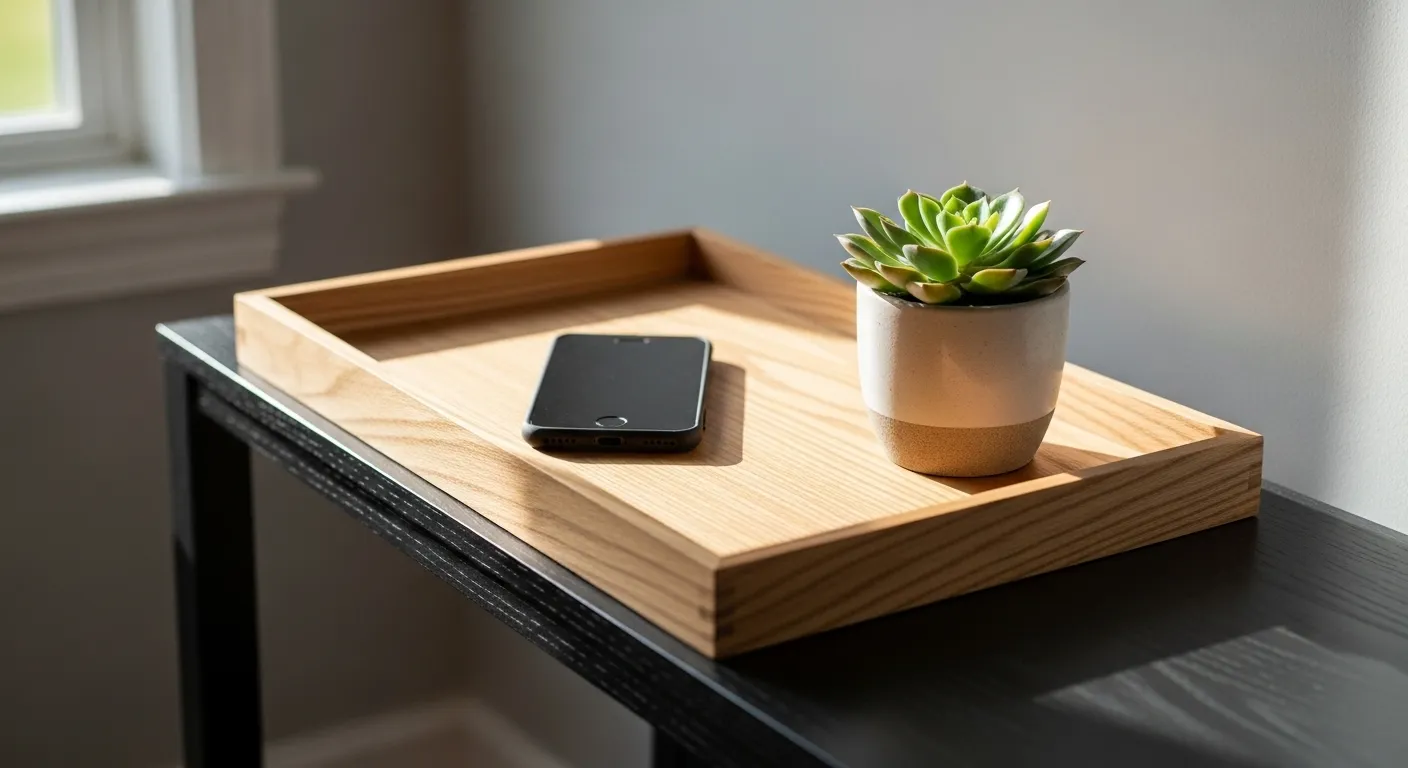
We love the myth of the productivity hero. We picture a brilliant mind, fueled by sheer willpower, conquering a mountain of tasks through nothing but grit and a gallon of coffee. It’s a compelling story, but it’s a fantasy. Heroic effort is brittle. It shatters under stress, crumbles with fatigue, and vanishes the moment a more interesting distraction appears.
Real, sustainable productivity isn’t built on herculean sprints. It’s built on small, intelligent systems. It’s about creating an environment where focus is the path of least resistance. And the single most disruptive element in your environment, the one that wages a constant war against your attention, is sitting in your pocket or on your desk right now.
Your smartphone is a marvel of connection and a vortex of distraction. But within its settings lies one of the most underrated productivity tools available: the “Do Not Disturb” feature. Most people treat it like a digital light switch—either on or off. They use it for meetings or movies, then immediately surrender control back to the digital noise.
A pro understands that “Do Not Disturb” isn’t a switch; it’s a dial. It’s a sophisticated instrument for crafting an intentional life. Mastering it is the first step in transforming your phone from a master of your attention into a servant of your goals. This isn’t about shunning technology; it’s about wielding it with purpose.
📚 Table of Contents
- The Silent Tyrant in Your Pocket: Why Default Settings Fail You
- Beyond the Crescent Moon: Advanced “Do Not Disturb” Setups
- Step 1: The Foundational Audit and Your VIP Whitelist
- Step 2: Automating Your Sanctuary with Schedules
- Step 3: The Pro Level—Context-Aware Focus Modes
- The Ecosystem of Focus: DND Doesn’t Work in a Vacuum
- The 10-Minute Desk Reset: Your Pre-Flight Checklist
- The 15-Minute Weekly Review: Setting Your Intentions
- The Power of a Mini Time Audit: The Unfiltered Truth
- Chaining Your Habits: How Small Wins Compound into Unbreakable Focus
- The Ultimate Focus Chain: A Step-by-Step Sequence
- A Crucial Guardrail: The Danger of Over-Optimization
- Putting It All Together: Two Real-World Scenarios
- Frequently Asked Questions About “Do Not Disturb” and Focus
- Isn’t this just about willpower? Why do I need tools?
- What’s the biggest mistake people make with Do Not Disturb?
- How do I handle the “switching cost” of turning focus modes on and off?
- What if I feel anxious about missing something important (FOMO)?
- When should I quit a productivity hack if it’s not working?
- Your First Steps to Reclaiming Your Focus Today
The Silent Tyrant in Your Pocket: Why Default Settings Fail You
Let’s be brutally honest. Your phone, out of the box, is not designed for your focus. It’s designed for the focus of a thousand different app developers, advertisers, and content creators. Every notification, every badge, every ping is a carefully engineered hook designed to pull you out of your world and into theirs. It’s a battle for your eyeballs, and by default, you are losing.
The sounds and vibrations are a constant, low-grade hum of anxiety. Did I miss something important? What was that buzz? Is it my boss or a 20% off coupon? This constant context-switching frays your cognitive resources. Even a notification you ignore exacts a mental toll. Your brain registers it, processes it, and spends a sliver of energy dismissing it. Do this a hundred times a day, and you end up with a full-blown case of digital exhaustion.
This is why relying on willpower to ignore your phone is a losing strategy. It’s like trying to diet while living in a candy store. The sheer volume of temptation will eventually wear you down. The solution isn’t stronger willpower; it’s a better-designed store. We need to introduce intentional friction. This is a core concept at The Focused Method: we make it slightly harder to do the things we want to do less, and dramatically easier to do the things we want to do more.
Using your phone’s “Do Not Disturb” feature like a pro is the ultimate act of creating intentional friction for distractions while paving a smooth, clear runway for deep work. It allows you to move from a reactive state, constantly parrying the digital blows of the outside world, to a proactive state, where you are the sole arbiter of what deserves your attention and when.

Beyond the Crescent Moon: Advanced “Do Not Disturb” Setups
Flipping on the basic “Do Not Disturb” is a start, but it’s like using a sledgehammer for a task that requires a scalpel. You block everything and risk missing a genuine emergency, creating a new kind of anxiety. The professional approach is nuanced. It involves telling your phone precisely who and what is allowed to pass the gate, and under what conditions.
Let’s build your system from the ground up. This isn’t just a list of settings; it’s a philosophy for curating your attention.
Step 1: The Foundational Audit and Your VIP Whitelist
Before you automate anything, you must define your rules. Go into your phone’s settings and find the “Do Not Disturb” or “Focus” menu. Your first decision is about calls. You’ll see an option like “Allow Calls From.” Most people set this to “All Contacts,” which is a mistake. It still allows hundreds of people to interrupt you.
Your mission is to curate a “Favorites” list in your contacts app that serves a single purpose: emergency access. This is not your list of best friends or favorite family members. This is your “the-house-is-on-fire” list. It should be incredibly short: your partner, your children’s school, your parents, perhaps your direct manager. That’s it. Now, set “Allow Calls From” to “Favorites” only.
Next, you’ll see a toggle for “Repeated Calls.” This allows a second call from the same number within three minutes to break through. This is your safety net for the unknown number that is truly urgent—a doctor’s office, for example. For most people, it’s wise to leave this turned on.
Step 2: Automating Your Sanctuary with Schedules
Your brain and body crave rhythm. One of the most powerful ways to improve your life is to protect your sleep. Use the scheduling feature to have “Do Not Disturb” turn on automatically 30 to 60 minutes before your bedtime and turn off when you wake up. This small act creates a digital sundown, signaling to your brain that it’s time to wind down. It prevents a late-night email from hijacking your thoughts just as you’re drifting off. The benefits to sleep quality are immense, as research from institutions like the Sleep Foundation consistently shows.
But don’t stop at sleep. If you have a recurring block of time for deep work—say, 9 AM to 11 AM every Tuesday and Thursday—create a schedule for it. Let your phone automatically enforce the boundaries you’ve chosen. Automation is crucial because it removes the daily decision-making and the willpower required to activate DND manually.
Step 3: The Pro Level—Context-Aware Focus Modes
This is where the magic happens. Modern smartphones (like iPhones with “Focus” and Androids with “Modes and Routines”) allow you to create multiple, distinct “Do Not Disturb” profiles that can trigger based on time, location, or even the app you’re using. Let’s build a “Deep Work” mode together.
First, create a new mode and name it “Deep Work.” Under “Allowed People,” select “None” or, at most, your tiny list of “Favorites.” Under “Allowed Apps,” be ruthless. Allow nothing that isn’t essential to the task at hand. Maybe a timer app, a specific music app, and a notes app. That’s it. No email, no social media, no news.
Now for the killer feature: the custom Home Screen. A Focus Mode can change what your phone’s screen looks like when it’s active. This is our one-screen phone settings tweak. Create a new, blank Home Screen page. On it, place only the widgets and apps you just allowed—your timer, your music app. When “Deep Work” mode is on, this minimalist screen is the only one you’ll see. The endless grid of distracting apps simply vanishes. The friction to get distracted becomes enormous; you’d have to actively disable the Focus Mode to even see the Twitter icon.
Finally, set your triggers. You can have this “Deep Work” mode turn on automatically when you arrive at your office. You can link it to your calendar, so it activates whenever an event titled “Focus Block” begins. Or you can create a simple one-tap shortcut on your main screen to toggle it on or off manually. You have now built a digital environment completely optimized for concentration.

The Ecosystem of Focus: DND Doesn’t Work in a Vacuum
Activating your perfectly configured “Deep Work” mode is a powerful step, but it’s only one piece of a larger puzzle. A quiet phone in a chaotic environment is still a recipe for failure. To truly achieve a state of flow, your digital sanctuary must be supported by a physical and mental one. Your “Do Not Disturb” feature is the gatekeeper; these supporting habits are the strong walls of the fortress.
These aren’t massive life overhauls. They are small, targeted micro-habits that, when combined with your DND strategy, create an unshakeable ecosystem of focus.
The 10-Minute Desk Reset: Your Pre-Flight Checklist
Think of a pilot before takeoff. They don’t just jump in the cockpit and hope for the best. They run through a meticulous checklist. The 10-Minute Desk Reset is your pre-flight checklist for deep work. Before you activate your “Deep Work” mode, take ten minutes to prepare your physical space. Clear away clutter from your desk—old mugs, stray papers, unnecessary gadgets. Have a glass of water, a pen, and a blank notepad within reach. Close the 27 browser tabs that have nothing to do with your current task.
This simple ritual does two things. First, it removes potential physical distractions. You won’t break your concentration to go find a pen. Second, and more importantly, it sends a powerful signal to your brain: “What is about to happen here is important. It’s time to focus.” It’s the psychological drawbridge being raised before you enter your castle of concentration.
The 15-Minute Weekly Review: Setting Your Intentions
You can have the most powerful focus system in the world, but if you don’t know what to focus on, it’s useless. The 15-Minute Weekly Review is your strategic command center. Once a week—perhaps on a Sunday evening or Monday morning—sit down with your calendar and a notebook. Look back at the previous week: what went well? What didn’t? Then, look at the week ahead. What are the most important things you need to accomplish?
This is where you can apply a framework like the 1-3-5 rule. For the upcoming week, identify your 1 most critical outcome, 3 medium-sized objectives that support it, and 5 smaller, necessary tasks. Once you have this clarity, you can look at your calendar and block out specific, non-negotiable “Focus Blocks” to work on them. These are the appointments with your own priorities that your DND system will protect.
The Power of a Mini Time Audit: The Unfiltered Truth
If you’re skeptical about how much notifications are truly affecting you, try a mini time audit. A time audit is simply the practice of tracking where your time actually goes, rather than where you think it goes. You don’t need a fancy app. For just one workday, grab a piece of paper. Every 30 or 60 minutes, take 30 seconds to jot down what you were just doing.
Be honest and non-judgmental. If you spent 20 minutes scrolling social media after a single notification buzzed, write it down. At the end of the day, review your log. Most people are shocked. They discover that their day wasn’t a series of long work blocks, but a fractured mess of micro-distractions. This single page of data is often more motivating than any productivity article. It provides the personal, undeniable proof that you need a system to protect your time. It builds the “why” behind your “how.”

Chaining Your Habits: How Small Wins Compound into Unbreakable Focus
Individual habits are good. Chained habits are transformative. The real power of The Focused Method comes from linking these small, simple actions together into a seamless sequence. This process reduces cognitive load—you don’t have to think about what to do next; the system runs itself. It builds momentum, where one positive action naturally flows into the next.
To do this effectively, we need to introduce two more concepts: batching and timeboxing.
Batching is the simple idea of grouping similar tasks together. Instead of answering emails as they arrive, you process them all in one or two dedicated “batches” per day. This prevents the constant “inbox-driven” workflow that destroys deep thought. You are in control of the communication, not the other way around.
Timeboxing is the practice of allocating a fixed period of time—a “timebox”—to a single task or a batch of tasks. You work on that one thing, and only that one thing, until the timer goes off. It’s not about finishing the task; it’s about giving it your full, undivided attention for the duration of the box.
Now, let’s see how we can chain these concepts together with our “Do Not Disturb” system into an unstoppable productivity sequence.
The Ultimate Focus Chain: A Step-by-Step Sequence
Imagine it’s Sunday evening. You’re doing your 15-Minute Weekly Review. You identify that writing the quarterly report is your most important task. You open your calendar and create a 90-minute event on Tuesday morning called “Focus Block: Draft Report.”
Tuesday morning arrives. Fifteen minutes before your scheduled block, your calendar reminds you. You begin your 10-Minute Desk Reset. You clear your space, get your water, and close unnecessary applications on your computer.
At 9 AM, your “Deep Work” Focus Mode, which is linked to your calendar, activates automatically. Your phone screen switches to its minimalist view. All notifications are silenced, except for your emergency contacts. You open a blank document, start your 90-minute timebox timer, and you begin to write.
For the next 90 minutes, you are fully immersed. There are no pings, no buzzes, no temptations. It’s just you and the work. When the timer goes off at 10:30 AM, your Focus Mode deactivates. You take a short break, and then you open your email. You create a new 25-minute timebox to batch process all the messages that came in while you were focused. You deal with them efficiently and then close your inbox.
In just over two hours, you have made significant progress on your most important task and cleared your communications backlog, all while remaining in complete control of your attention. Each step cued the next. The system, not your willpower, did the heavy lifting.
A Crucial Guardrail: The Danger of Over-Optimization
A word of caution. It’s easy to become so enamored with building the “perfect” system that you spend more time tinkering with your tools than doing the actual work. This is a form of productive procrastination. Your system should serve you, not the other way around.
If your system is so rigid that a single unexpected meeting throws your entire day into chaos, it’s too brittle. The goal is not to become a robot, executing a flawless program. The goal is to create a robust structure that allows for more frequent and higher-quality deep work, while still leaving room for the spontaneity and flexibility that life requires. Start with a simple chain. Master it. Then, and only then, consider adding more complexity if needed.

Putting It All Together: Two Real-World Scenarios
Theory is useful, but seeing these systems in action is what makes them click. Let’s explore how two very different professionals can adapt the “Do Not Disturb” philosophy to solve their unique focus challenges.
Scenario 1: The Manager Drowning in Meetings
The Person: Sarah, a mid-level manager with a team of eight. Her calendar is a wall of back-to-back video calls. Her days are spent reacting to Slack messages and email chains, leaving her with zero time for the strategic planning that is a core part of her job. She feels more like a switchboard operator than a leader.
The Problem: Constant, legitimate interruptions from her team and superiors make it impossible to engage in deep, strategic thinking. She can’t just go “off the grid” for hours at a time.
The DND Solution: A “Strategic Work” Mode
Sarah’s approach needs to be surgical. During her 15-Minute Weekly Review, she identifies the one or two strategic questions she must answer that week. She then blocks out two 75-minute “Strategic Work” slots in her public calendar, treating them as seriously as a meeting with her own boss.
She creates a new Focus Mode on her phone called “Strategic.”
- Allowed People: She sets this to her curated “Favorites” list, which includes her direct manager and her spouse. This gives her peace of mind that a true emergency can get through.
- Allowed Apps: She allows notifications from her Calendar and her company’s primary messaging app, but only from specific people—her manager and her two senior team leads. Most modern apps allow this level of granular control. All other app notifications are silenced.
- Activation: She links this Focus Mode to her calendar. It turns on automatically the moment her “Strategic Work” appointments begin and turns off when they end.
The Result: Sarah reclaims 2.5 hours of high-quality thinking time each week. Her team learns that during these blocks, only urgent operational issues should be escalated through the designated channels. She is still accessible for true emergencies but is shielded from the constant “noise.” She starts making progress on long-term goals, not just surviving the day’s fires.
Scenario 2: The Solo Maker on a Deadline
The Person: David, a freelance graphic designer working from a home office. He has a major client project due in two weeks. His biggest challenge isn’t meetings; it’s self-distraction. The siren song of social media, news alerts, and personal text threads constantly pulls him out of his creative flow.
The Problem: The lack of external structure makes it easy for “just a quick check” of his phone to spiral into an hour of lost time. He needs to create firm, artificial boundaries to protect his most creative and productive hours.
The DND Solution: An Aggressive “Maker Mode”
David’s system can be much more draconian because he is accountable only to himself and his clients’ deadlines. He needs to build a fortress against his own impulses.
He creates a Focus Mode called “Maker Mode.”
- Allowed People: None. He uses the “Repeated Calls” feature as his only safety net. He knows a true emergency will try to call twice.
- Allowed Apps: None. He doesn’t need any apps for his design work, which happens on his computer.
- Custom Home Screen: His “Maker Mode” triggers a custom Home Screen that contains literally nothing. It’s a blank page. The friction to find a distracting app is now monumental.
- Activation: He creates a simple time-based schedule. “Maker Mode” turns on every weekday from 9:00 AM to 12:00 PM, his peak creative window.
The Result: David has created a non-negotiable container for deep work. During those three hours, his phone ceases to be a source of distraction. He pairs this with batching, committing to checking email and social media only at noon and 4 PM. His productivity soars, the project gets done ahead of schedule, and his stress levels plummet because he knows his most important work is protected by a system, not just his fluctuating willpower.

Frequently Asked Questions About “Do Not Disturb” and Focus
Adopting a new system always brings up questions. Here are answers to some of the most common ones we hear from people implementing The Focused Method, to help you troubleshoot and solidify your new habits.
Isn’t this just about willpower? Why do I need tools?
This is a fundamental misunderstanding of how human attention works. Willpower, or what psychologists often call self-control, is an exhaustible resource. As detailed in endless studies from sources like the American Psychological Association, making decision after decision—even small ones like “should I check this notification?”—depletes your capacity for self-regulation. Tools and systems don’t replace willpower; they conserve it. By creating an environment where distractions are automatically blocked, you save your precious willpower for the actual work itself. It’s not about being weak; it’s about being smart.
What’s the biggest mistake people make with Do Not Disturb?
The biggest mistake is the “all or nothing” approach. People either use the default, blunt-force DND, which makes them anxious about missing an emergency, causing them to turn it off prematurely. Or, they don’t use it at all because they fear that anxiety. The professional approach is nuanced. It’s about using the settings—the whitelists, the schedules, the custom modes—to create a filter that is perfectly suited to your context. It should block 99% of the noise while giving you 100% confidence that the truly critical signals can still get through.
How do I handle the “switching cost” of turning focus modes on and off?
Switching cost is the mental energy you lose and the time it takes to reorient yourself when you shift from one task to another. Manually turning DND on and off is, itself, a small task with a switching cost. The primary way to combat this is through automation. This is why we emphasize using schedules, location triggers, and calendar-based activation. The goal is to “set it and forget it.” You make the high-level decision once during your weekly review (e.g., “I will focus from 9-11 AM on Tuesday”), and you let the technology handle the tactical execution of turning the mode on and off. This reduces the switching cost to zero.
What if I feel anxious about missing something important (FOMO)?
This anxiety is real, but it’s often based on a false premise. The fear is that something urgent and important will happen, and you will be unreachable. First, your VIP whitelist and repeated call settings are your safety net against this. Second, start small to prove to yourself that the world will not end. Use your new “Deep Work” mode for just one 25-minute Pomodoro session. When the timer goes off, check your phone. You will almost certainly find that nothing catastrophic happened. By collecting these small pieces of evidence, you gradually retrain your brain to understand that most communication is not urgent. The anxiety fades as your confidence in the system grows.
When should I quit a productivity hack if it’s not working?
Give any new habit or system an honest trial period, typically one to two weeks. This gives you time to get past the initial awkwardness. During that time, observe: is this system adding more friction and stress than it’s removing? Is the time you spend managing the system greater than the time it saves you? If, after a fair trial, a hack feels like a burden, don’t be afraid to modify it or discard it entirely. The goal is not rigid adherence to a specific dogma; the goal is to find what makes you more effective and less stressed. Productivity is personal.

Your First Steps to Reclaiming Your Focus Today
Reading about productivity is one thing; taking action is another. The entire philosophy of The Focused Method is built on small, immediate steps that generate momentum. You don’t need to build the entire system we’ve discussed right now. You just need to lay the first stone. Let’s transform this knowledge into action in the next ten minutes.
Your “Do Not Disturb” feature isn’t just a button; it’s a declaration. It’s a statement that your time is valuable, your attention is a precious resource, and you are in control. It’s the lever that, when pulled correctly, begins the process of realigning your daily actions with your deepest intentions.
Here are three simple, high-impact actions you can take right now to begin using your phone’s “Do Not Disturb” like a pro.
Action 1: The 5-Minute VIP Audit. Open your phone’s Contacts app. Go to your “Favorites” list. Be ruthless. Remove everyone who is not on your absolute, must-get-through-in-a-disaster list. Think spouse, children’s school, aging parents. Then, go to your DND settings and set “Allow Calls From” to “Favorites.” This single act instantly elevates the power of DND from a blunt tool to a precision instrument.
Action 2: Schedule Your Sleep. While you’re in the DND settings, find the “Schedule” or “Automation” option. Create a new schedule for sleep. Set it to turn on 30 minutes before you typically go to bed and turn off when your alarm goes off. This is a powerful investment in your health and cognitive function, as consistently recommended by organizations like the National Institutes of Health. It costs you nothing and pays dividends in mental clarity every single day.
Action 3: Block One Hour. Open your calendar for tomorrow. Find a single 60-minute slot that is currently free. Create an event and title it “Focus Time.” When that time arrives tomorrow, don’t overthink it. Simply swipe down and manually activate the basic “Do Not Disturb” mode. Set a timer for 60 minutes and work on one important task. That’s it. You are taking the first step in scheduling an appointment with your own priorities.
These are not life-altering changes. They are small, almost trivial, adjustments. But they are the beginning of a system. They are the seeds from which true, sustainable focus grows. Stop waiting for a heroic burst of willpower. Take control of your environment, one setting at a time. Start today.
Disclaimer: The information provided in this article is for educational and informational purposes only and is not intended as a substitute for professional medical, psychological, or legal advice. Always seek the advice of a qualified professional with any questions you may have.






